Centauri Dreams
Imagining and Planning Interstellar Exploration
Musings on Impartiality
Marc Millis, Tau Zero’s founding architect, drawing on his experience with NASA’s Breakthrough Propulsion Physics project and the years of research since, offers us some ideas about impartiality and how scientists can hope to attain it. It’s human nature to want our particular theories to succeed, but when they collide with reality, the lessons learned can open up interesting alternatives, as Marc explains in relation to interstellar worldships and the possibilities of exotic propulsion.
by Marc G. Millis
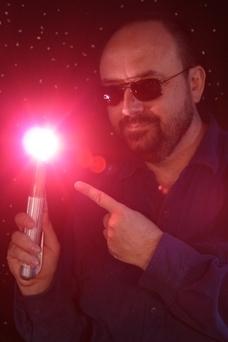
The best researchers I know seem to be able to maintain their impartiality when reaching new conclusions. The more common behavior is that people get an idea stuck in their head and then try and prove themselves correct. I just learned that there is a term for this more common behavior: “Polemical.” Embedded in the word is the notion that controversial argument can turn aggressive, an inevitable result when people are defending what they consider their turf.
I mention this in the context of getting trustworthy results, and then acting on those reliable findings rather than just charging ahead based on unverified preconceived notions. If the overall intent is to make the best decisions for the future – then decisions rooted in reliable findings, rather than expectations, will be more in tune with reality. They will be better decisions.
The topic of interstellar flight affords opportunities for easier objectivity as well as the opposite – pitfalls where one can lose objectivity. Because interstellar flight is almost certainly farther in the future than the next Moon and Mars missions, it is easier to apply impartiality. The huge payoffs of interstellar flight (finding new human homesteads and new life) are far enough away that there is no need to sell a particular pet technology today or skew the results toward near-term promises.
That said, I surprised myself when my own assessments gave results different than my expectations. Case in point – estimating how far in the future the first interstellar missions are, based on energy (energy is the most fundamental currency of motion). Those findings and a refined sequel (to appear soon in the Journal of the British Interplanetary Society) indicate that the first interstellar missions might be 2-centuries away, albeit with huge uncertainty bands.[ref]Millis, Marc. (2010) First Interstellar Missions, Considering Energy and Incessant Obsolescence, JBIS Vol 63 (accepted, pending publication).[/ref] The first Centauri Dreams post on those findings met with ‘energetic’ reaction, where many seemed disappointed that the prospects seemed so far in the future. Before I ran the numbers, I suspected that it would be much sooner too. The first calculations were done around 1996, and those results made me rethink what ‘next-steps’ were really required.
Rather than proceed with my prior notion, I had to stop and rethink things. The data said something unexpected. I knew I had conceived the methods to be impartial and fed the assessments with unbiased data, so the findings would be similarly unbiased. They were what they were. So, should I redo the analysis until I got the answer I wanted, or accept the results for what they were and then re-adjust my expectations? I decided to expose those results to other reviews, to check for errors and such, and then to accept the findings as they were.
Before that point, I thought the next step would be to use more detailed energy assessments to help pick the best interstellar propulsion options, but with two centuries of time to plan ahead, and many options whose numbers were still debatable, I realized that we need to abandon the idea of trying to pick the ONE best interstellar solution. Instead we need to focus on getting reliable data on the wide span of ideas (no salesmanship) – and to investigate the most critical ‘next-steps’ on as many of them as possible.
And this long lead time provides the topic of interstellar flight with the opportunity for more objectivity – the opportunity to take our time to reach sound decisions – to provide more trustworthy progress.
Colony Ships and Spaceship Earth
The other result that I was not expecting was that colony ships might be easier to launch than small, fast probes – at least in terms of energy. My prior expectations were that colony ships would need to be so immense and complicated that they would take longer to develop than a fast probe to Alpha Centauri. The energy study showed otherwise. Kinetic energy is linear in mass, and goes as the square of speed. That means if the ship is twice as massive, it requires twice as much energy, but if it goes twice as fast, it requires FOUR times the energy. Colony ships do not need to go fast. They only need to drift, carrying a segment of humanity. Up to that point, I thought colony ships would be a sequel, not a prequel to small, ultra-fast probes. Sometimes you just have to run the numbers.
Then it occurred to me, while I was drafting my first TEDx talk, that the notion of such slower interstellar world ships also provides a more impartial venue to discuss critical human survival questions. Colony ships allow us to consider these questions with NO dependence on conventions or biases. If designing a society from scratch, one is free to start anew to fit the facts as they are discovered. On Earth, however, when dealing with questions of population size, environmental stability, amount of territory per person, and governance model, the debates are typically won by cultural edict (e.g. no birth control) or warfare (quest for territory or power). So, after all that, I realized that colony ships merited far more attention than I originally gave them, and hence, we will need to track down suitable pioneers to cover those issues too as part of Tau Zero.
Unbiased Physics
When it comes to one of my pet topics – propulsion physics and the quest for space drives – I ran into another facet of impartiality. I found that many physicists do not like to work on problems with potential applications since the application ‘taints the purity’ of the research. Instead they want to be driven by curiosity alone. In other words, they do not want to be biased. In the quest for propulsion physics, where I really hope a space drive method can be found, I have an ingoing bias. I want the results to turn out a certain way. This creates a conflict of interest in how I might view – or skew – the results. To make genuine discoveries, however, I must discipline myself to avoid imposing such biases. Although I can let my wishful musings help me pose the key questions, to get real progress I must also let the findings – unbiased findings – answer those questions. I must accept the results as they unfold.
Take the case of black holes in contrast to traversable wormholes or even warp drives. Studying black holes has revealed insights about spacetime warping, presumably without bias since no desired result is sought. But if one studies the very same physics in the context of faster-than-light wormholes or warp drives, one might get biased results because of wanting such devices to be feasible. Fortunately, much research published on these topics has maintained the rigor to avoid the taint of such biases. Insights into spacetime physics are also being learned by pondering warp drives and wormholes. These questions are even presented as homework problems in textbooks (e.g. Hartle (2003) Gravity: An Introduction to Einstein’s General Relativity).
The irony is that even the curiosity-driven research has implicit biases – that natural sense of ownership that a person has for their research ideas. There is an urge – even in this case – to have the findings prove the author’s pre-conceived point. This is just a human norm. High-quality physicists can discipline themselves to separate out this bias. In contrast, I’ve also seen physicists discuss their ideas with the same possessiveness as kids with toys on a playground. Regardless of our motivation in searching for new knowledge, we must maintain vigilance to avoid imposing our own biases on the findings, even the implicit bias of self.

More Evidence for Enceladus Ocean
The latest work involving Cassini’s Cosmic Dust Analyzer (CDA) gives us fresh information about Saturn’s intriguing moon Enceladus and the likelihood of an internal ocean there. You’ll recall that plumes of water vapor and grains of ice have been found spewing from the ‘tiger stripe’ fractures at the moon’s southern pole, feeding material to Saturn’s E ring. Three times during the spacecraft’s passes through the plumes of Enceladus in 2008 and 2009, the CDA measured the composition of plume grains. Some of these icy particles struck the detector moving at speeds of up to 17 kilometers per second, vaporizing them on impact. The particle constituents could then be separated for close study.
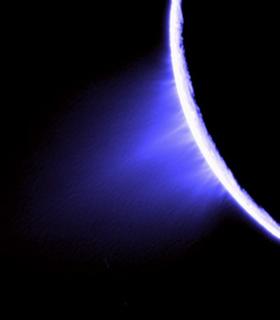
What we find is that the ice grains most distant from Enceladus are poor in ice and match the composition of Saturn’s E ring. But move closer to the moon and large, salt-rich grains begin to appear. If the plumes came only from surface ice, we would expect little salt rather than the ‘ocean-like’ composition of the salt-rich particles. That’s an interesting result indeed, says Frank Postberg ( Universität Heidelberg), lead author of a study being published in Nature on June 23. “There currently is no plausible way to produce a steady outflow of salt-rich grains from solid ice across all the tiger stripes other than the salt water under Enceladus’ icy surface,” the scientist adds. And co-author Sascha Kempf (UC-Boulder) expands on the idea:
“The study indicates that ‘salt-poor’ particles are being ejected from the underground ocean through cracks in the moon at a much higher speed than the larger, salt-rich particles. The E Ring is made up predominately of such salt-poor grains, although we discovered that 99 percent of the mass of the particles ejected by the plumes was made up of salt-rich grains, which was an unexpected finding. Since the salt-rich particles were ejected at a lower speed than the salt-poor particles, they fell back onto the moon’s icy surface rather than making it to the E Ring.”
Image: Water vapor jets spewing from Saturn’s icy moon Enceladus. (Credit: NASA/JPL/Space Science Institute).
The layer of water these researchers are talking about would lie perhaps as much as 80 kilometers below the surface crust, presumably kept in a liquid state by the tidal forces created not only by Saturn but by several neighboring moons, along with the heat of radioactive decay. A crack in the outermost crust exposes some of this water to space, causing flash-freezing into salty ice grains along with accompanying water vapor. The scientists’ calculations show that the liquid ocean must have a sizable evaporating surface or the plumes would freeze over. About 200 kilograms of water vapor are lost every second from the plumes, along with smaller amounts of ice grains.
Enceladus is but a single moon, but what it seems to be telling us is that icy bodies orbiting gas giants may sustain large amounts of liquid water, a finding of obvious interest to astrobiologists. As for Enceladus itself, the paper’s abstract notes that “Whereas previous Cassini observations were compatible with a variety of plume formation mechanisms, these data eliminate or severely constrain non-liquid models and strongly imply that a salt-water reservoir with a large evaporating surface provides nearly all of the matter in the plume.”
The paper is Postberg et al., “A salt-water reservoir as the source of a compositionally stratified plume on Enceladus,” published online 22 Jun 2011 in Nature (abstract).

IceHunters.org: Probing for KBOs
New Horizons’ encounter with Pluto/Charon in 2015 is eagerly anticipated, but let’s not forget that the spacecraft will be operational afterwards as it moves deeper into the Kuiper Belt. Fuel will be tight, but there should be enough available for one and possibly a second encounter with a Kuiper Belt Object (KBO), assuming we can identify a likely candidate. I’m often asked how such targets would be chosen, and here’s one answer: A new site called IceHunters has been set up at Southern Illinois University that will draw the public into the hunt for icy objects.
At the heart of the IceHunters project are images made by some of the world’s largest telescopes (most come from the 6.5-meter Magellan telescope in Chile and the 8-meter Subaru telescope on Mauna Kea), of the region where potential targets will be found. Like SETI@Home, IceHunters leverages widely distributed PCs in the hands of end-users worldwide. Check the site and you’ll see that instead of conventional astronomical images, you’re looking at ‘difference images’ — produced by subtracting two images as a way of removing non-moving objects like stars and galaxies. Of course, these objects actually are moving in their own right, but the method should help Kuiper Belt objects and asteroids stand apart from the pack.
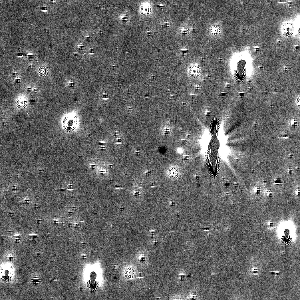
Images like these play havoc with computers but a critical human eye can, with skill, pick out unknown objects. KBOs and asteroids can be marked by anyone with an up to date Web browser. Pairs of images taken at different time intervals are subtracted from each other, but as the image shows, it’s impossible to equalize the appearance of the stars perfectly before the subtraction process occurs. As a result, we wind up with blotches and other odd marks where star residuals are found.
Image: To make the pesky stars disappear the two images are subtracted from one another. This doesn’t make the stars go entirely away. Even with the blurring step, the two images aren’t exactly identically and instead of having 1-1 = 0, we have something more like 1.01432 – 1 is not 0. Where the first image was brighter, a bit of white shows in the image. Where the second image was brighter, there is a bit of black. The KBO stands out in this image as both a dark blob (from being in the second image) and a white blob (from being in the first image). Credit: IceHunters.org.
It’s amazing to realize as we embark on this search that other than Pluto, the first Kuiper Belt Object wasn’t discovered until 1992. That was the work of Dave Jewitt and Jane Luu at the University of Hawaii, who discovered the object designated 1992QB1 at about 40 AU from the Sun. Although the Kuiper Belt is one of the least mapped regions of our system, we’ve now found more than 1,000 objects beyond Neptune’s orbit, and current estimates are that as many as half a million KBOs larger than 30 kilometers or so in diameter are lurking out at system’s edge.
IceHunters images are drawn from a roughly 2-square degree field in Sagittarius, chosen because objects here would have the potential to be near New Horizons’ trajectory after its 2015 encounter with Pluto/Charon. The KBOs discovered will be collected into a catalogue and published with the name of their discoverers, another chance for citizen scientists to make a tangible mark in their field.
“Projects like this make the public part of modern space exploration,” says SIUE assistant research professor Pamela Gay. “The New Horizons mission was launched knowing we’d have to discover the object it would visit after Pluto. Now is the time to make that discovery, and thanks to IceHunters, anyone can be that discoverer.”
The first KBO chosen as a target won’t be selected until just before the encounter with Pluto/Charon, but the hope is to identify a KBO at least 50 kilometers across. The procedure for this encounter would roughly parallel what happens at Pluto. The spacecraft will be making global maps of Pluto and Charon at various wavelengths and taking high-resolution images to study the surface composition of these objects. New Horizons will pass within 12,500 kilometers of Pluto itself (29,000 kilometers from Charon) and will see Plutonian features as small as 100 meters across.
Much of the work will continue even as the spacecraft passes Pluto, looking back to take atmospheric measurements as New Horizons moves into the shadows of Pluto and its largest moon. Assuming all goes well, the Pluto/Charon encounter might be a warmup for the second or even third flyby of a KBO. Getting the eyes of the public on IceHunter’s ground-based images may uncover the identity of the spacecraft’s targets as they move through the vast stellar background. In any case, it’s a way of doing good science to build up a broader picture of the Kuiper Belt population.

A Trio of Black Hole Studies
Big explosions make news, as proven by ubiquitous reports in the popular media about a distant star that wandered too close to the black hole at the center of its galaxy. The beam of energy that resulted from its destruction was composed of high-energy X-rays and gamma rays, and was unusual not only for its brightness but its duration. The event has persisted for more than ten weeks as pieces of the star fell into the black hole, with a brightness at optical and infrared wavelengths that at its peak equalled that of a hundred billion suns.
How do you get a beam that bright? Evidently this one was pointed directly at our galaxy, concentrating the signature of the event into a small fraction of the sky. Andrew Levan (University of Warwick), says we saw the cataclysm only because “…our solar system happened to be looking right down the barrel of this jet of energy.” The source of the event, which is now called Swift 1644+57, is at the heart of a galaxy some 3.8 billion light years away.
“The best explanation that so far fits the size, intensity, time scale, and level of fluctuation of the observed event, is that a massive black hole at the very center of that galaxy has pulled in a star and ripped it apart by tidal disruption,” adds Levan. “The spinning black hole then created the two jets, one of which pointed straight to Earth.”
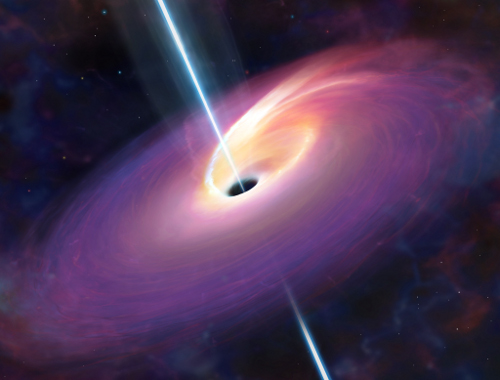
Image: An artist’s impression of the formation of two jets of energy at Swift 1644+57. Credit: University of Warwick / Mark A. Garlick.
Black Holes in the Early Universe
Looking down the barrel of such an event is a rarity indeed, but other recent studies augmenting our knowledge of black holes are equally impressive. A team of astronomers using images taken by the Chandra X-Ray Observatory, for example, has now detected the earliest black holes ever found. The most distant of the galaxies containing them are some 13 billion light years from Earth, so we are looking at black holes as they existed less than a billion years after the Big Bang. The astronomers could measure the X-ray signals being produced by the black holes as they consumed gas and dust.
These are tricky observations indeed, but the work confirms that the black holes grow along with their galaxies, revealing what Kevin Schawinski, a Yale astronomer who contributed to the discovery, calls “…a symbiotic relationship between black holes and their galaxies that has existed since the dawn of time.” Adds Yale cosmologist Priyamvada Natarajan:
“These observations indicate that extremely massive black holes already existed as early as 700-800 million years after the Big Bang, which suggests that either they were born massive to start with, or they experienced rapid growth bursts. Either scenario tells us much more than we previously knew, which is very exciting.”
Binary Black Holes at Markarian 739
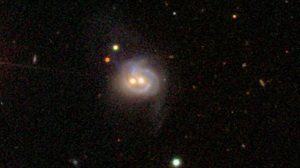
Finally, NASA’s Swift satellite and Chandra were again put to use in the discovery of a second massive black hole at the center of the nearby galaxy called Markarian 739 or NGC 3758, some 425 million light years away toward the constellation Leo. The two black holes are separated by approximately 11,000 light years. It’s now believed that most large galaxies — our Milky Way is no exception — house a supermassive black hole. Those galactic centers producing intense emissions are known as active galactic nuclei, found in about one percent of such galaxies. A binary AGN is rarer still.
“If two galaxies collide and each possesses a supermassive black hole, there should be times when both black holes switch on as AGN,” said coauthor Richard Mushotzky, professor of astronomy at UMCP. “We weren’t seeing many double AGN, so we turned to Chandra for help.”
Image: Viewed in visible light, Markarian 739 resembles a smiling face, with a pair of bright cores underscored by an arcing spiral arm. The object is really a pair of merging galaxies. Data from Swift and Chandra reveal the western core (right) to be a previously unknown AGN; past studies already had identified an AGN in the eastern core. The two supermassive black holes are separated by about 11,000 light-years. The galaxy is 425 million light-years away. Credit: SDSS
Markarian 739 is one of the nearest cases of a binary AGN. The paper on the discovery is Koss et al., “Chandra Discovery of a Binary AGN in Mrk 739,” accepted by Astrophysical Journal Letters (preprint). On Sw 1644+57, see Bloom et al., “A Possible Relativistic Jetted Outburst from a Massive Black Hole Fed by a Tidally Disrupted Star,” published online 16 June 2011 by Science (abstract). On early black holes, see Treister et al., “Black hole growth in the early Universe is self-regulated and largely hidden from view,” Nature 474 (16 June 2011), pp. 356-358 (abstract).

Analyzing a ‘Hyperactive’ Comet
We’ve certainly gotten our money’s worth out of the spacecraft once called ‘Deep Impact.’ A mission designed for close study of a comet (Tempel 1) winds up making extrasolar planet investigations in an extended mission called EPOCh (Extrasolar Planet Observations and Characterization), sends back imagery of the Earth and its moon that deepens our knowledge of terrestrial world observations, and flies by another comet, Hartley 2, in its DIXI phase (Deep Impact Extended Investigation ). Add it all up and you get the combined acronym EPOXI.
Have a look at the range of comets that have been studied by spacecraft thus far:
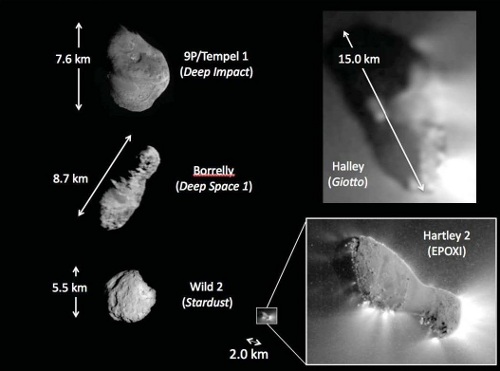
Image: Images at the same scale for all cometary nuclei observed by spacecraft. Differences in overall shape are dramatic, as are the differences in contrast between the nuclei and their associated jets, which are brighter than the nucleus at Halley and Hartley 2 and much fainter than the nucleus at other comets. Credit: Science/AAAS.
Now we have further analysis of the Hartley 2 flyby, which occurred last fall, with a paper in Science that draws on an imaging period that totalled almost three months, compiling more than 117,000 images and spectra of the comet. Scientists are now referring to the object in terms that make it sound more like a young colt — or a crafty baseball pitcher — than an ancient relic of the Solar System. Thus EPOXI project manager Tim Larson (JPL):
“From all the imaging we took during approach, we knew the comet was a little skittish even before flyby. It was moving around the sky like a knuckleball and gave my navigators fits, and these new results show this little comet is downright hyperactive.”
That hyperactivity refers to the fact that Hartley 2 is spewing out a great deal of water and carbon dioxide, more than other comets of its size. When EPOXI closed to within 694 kilometers of the comet, it found the release of water and jets of carbon dioxide occurred asymmetrically. While carbon dioxide was being released predominantly at the ends of the comet, water was being released as a vapor from the middle region, or ‘waist.’ Evidently material from the ends is being redeposited in the waist areas as frozen carbon dioxide is warmed and turns into a gas.
This is an important point because it would mean that the material on the waist is not primordial but evolutionary:
“We think the waist is a deposit of material from other parts of the comet, our first evidence of redistribution on a comet,” said University of Maryland Astronomer Jessica Sunshine, who is deputy principal investigator for the EPOXI mission. “The most likely mechanism is that some fraction of the dust, icy chunks, and other material coming off the ends of the comet are moving slowly enough to be captured by even the very weak gravity of this small comet. This material then falls back into the lowest point, the middle.”
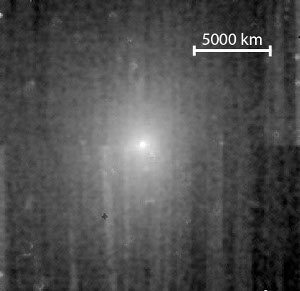
In the case of Hartley 2, we’re looking at a comet that spins around one axis and tumbles around another, a place where glittering blocks that can reach 50 meters in height and 80 meters in width — and whose nature is still undetermined — dot the larger, rougher ends, and are two to three times more reflective than the surface average. Still another surprise was the increase in cyanogen (CN) gas in the comet’s coma — 10 million times more CN gas was given off in one nine-day period in September than would have been expected. Lucy McFadden (NASA GSFC) comments on what scientists are calling the ‘CN anomaly’:
“We aren’t sure why this dramatic change happened. We know that Hartley 2 gives off considerably more CN gas than comet Tempel 1, which was studied earlier by a probe released by the Deep Impact spacecraft. But we don’t know why Hartley 2 has more CN, and we don’t know why the amount coming off the comet changed so drastically for a short period of time. We’ve never seen anything like this before.”
Image: A large, diffuse cloud of CN gas surrounds the nucleus of Hartley 2 in this image from NASA’s EPOXI mission. The gas forms a cloud of more than 200,000 kilometers (about 124,000 miles) in radius, compared to the comet’s size of about 2 kilometers (1.24 miles). Credit: NASA/JPL-Caltech/UMD.
You may recall from an earlier article here that Jessica Sunshine, referred to earlier, is principal investigator for the proposed Comet Hopper mission, one of the recent finalists for selection in NASA’s Discovery Program. Hartley 2 is demonstrating how much we still have to learn about how comets behave. Other comets known to be as ‘jumpy’ as this one are presumably driven by carbon dioxide or carbon monoxide, but we don’t know whether these represent a separate class of comets or simply reflect a continuum of cometary activity that will become clear with more observation, one reason why Sunshine would like to land a moveable probe on another comet (46P/Wirtanen), observing changes on the comet as it moves closer to the Sun.
It’s also fascinating that the smaller end of comet Hartley 2 seems to release twice the amount of carbon dioxide relative to the amount of water released as the large end, perhaps a reflection of a difference in composition between the two ends that has been there since formation. Observations from the ground can follow up the EPOXI results to continue the study of Hartley 2’s rotation and the variations in the gas and dust that surround the comet. As to Comet Hopper, we’ll have to wait for NASA’s 2012 review to see whether it or one of the alternatives — Titan Mare Explorer or the GEMS mission to Mars — will be the mission chosen to fly.
The paper is A’Hearn et al., “EPOXI at Comet Hartley 2,” Science Vol. 332 No. 6036 (17 June 2011), pp. 1396-1400 (abstract).

A Look Inside the 100 Year Starship Idea
Technology fails at the damnedest times, which is particularly ironic when discussing something as futuristic as a starship. But then, a starship launched in a hundred or more years won’t be worrying about small cassette recorders like my little Olympus, which chewed up the tape on which I was recording the June 16 teleconference held by DARPA’s David Neyland about the 100 Year Starship Study. Fortunately, I am a wizard at note-taking by hand, which comes from my love of fountain pens (I collect and repair vintage instruments) and enjoyment of script on a yellow legal pad. I always take notes by hand as well as taping where possible, a good thing because I didn’t realize what had happened to the tape until after the teleconference had ended.
Neyland, who is director of DARPA’s Tactical Technology Office, is an engaging man with a bit of a penchant for science fiction — he mentioned Heinlein as an inspiration, but also gave credit to Jules Verne. After all, it was all the way back in 1865 that Verne came up with From the Earth to the Moon, a remarkable achievement, Neyland noted, when you considered that the US was just coming out of the Civil War at that time. Yet Verne’s imagination not only delivered an idea, but also managed to communicate the excitement of a lunar voyage to later generations. That 100-year time interval fed into Neyland’s thinking about what might come to fruition another century from now, and conversations with Pete Worden at NASA Ames firmed up the idea.
The 100 Year Starship is intended as a small study that will produce ancillary benefits. If you think back to DARPA’s role in the technology of today, Neyland said, what comes to mind right away is the Internet. DARPA did not, contrary to some popular accounts, invent the Internet. What it did do was to come up with ways to connect wired computers and facilitate the exchange of data between them. You can find other examples, as Neyland did: GPS technology received early DARPA attention in the 1960s, while the methods by which cellular telephone towers exchange information, used all over the world, were another early DARPA investment.
Can a starship study produce ancillary benefits? Presumably it can, and those benefits might run across a wide spectrum of human needs starting with energy. Neyland likened what the 100 Year Starship Study is trying to do to the early space program, recalling that many of the benefits from that effort simply faded into commonplace reality as time went by. “If you’ve ever gone into a store and bought a DeWalt drill,” he noted, “you probably don’t think about the fact that cordless drill and battery technology like this goes back to tools needed in the space program.”
So where is all this going? Centauri Dreams readers will recall that there was a conference in California last January in which issues about starship development, ranging all the way from the physics involved to philosophy and ethics, were discussed. A synopsis of the workshop is about to be released on the 100 Year Starship Study Web site.
Addendum: The synopsis is now available.
We’ve recently talked about the study’s Request for Information, and published two responses in these pages. Neyland said there were over 150 responses to the RFI, but acknowledged that they ranged across the board, from serious examinations of the issue to applications to join the starship’s crew (about as big a misreading of what the 100 Year Starship Study is trying to accomplish as is imaginable).
A Request for Proposals will be out by mid-summer, followed by a symposium in Orlando — I’ve already posted the DARPA news release on that one. In November, a grant will be provided to a single organization or individual, assigning what is left of the original seed money, $1 million of which came from DARPA and $100,000 from NASA — the grant should total in the vicinity of $500,000. Making the case for why their organization should be awarded the grant will be the work of those proposing ideas through the RFP process, at which point, when the grant is awarded, Neyland said that NASA and DARPA will both walk away from the effort. It will be up to the winner of the grant to turn the 100 Year Starship idea into a long-term commitment.
So there you are. The idea is to seed a project that will produce spin-offs ranging from agriculture to propulsion to ethics and environmental issues, in the DARPA way of funding new efforts and letting them bloom. Benefits should accrue in research and education along the way, with success in developing the work leading to a cycle of investments that can bring more money in to become a self-sustaining effort. So I stress again, the 100 Year Starship Study (to which the Tau Zero Foundation, among others, will be making a proposal) is not about building a starship. It is about solving problems that will one day have to be solved, with spinoffs along the way, and the hope that the technologies developed may one day evolve into the real thing.


